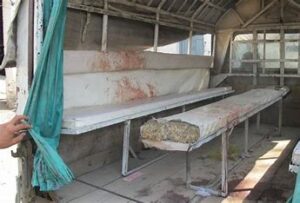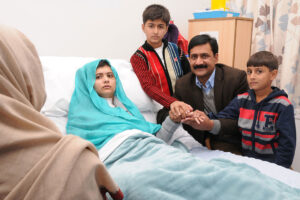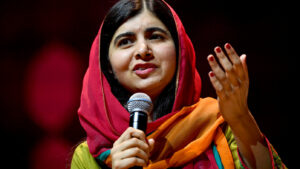
A singular click shattered the silence. A bullet wasn’t the only thing let out that day, but the sound of freedom coming. This was a pivotal moment in Malala Yousafzai’s life, whose story is a remarkable journey from a courageous young woman who advocated for girls’ education in Swat Valley under Taliban rule. Her story leaves everyone who hears it inspired, especially girls in education. Malala’s story isn’t just a narrative; it’s a testament to the indomitable spirit that can rise from the dark.
Advocates Against Injustice
Malala became an activist at the tender age of eleven, when the men in Pakistan made the appalling decision that girls did not belong in school on January 15th, 2012, and that women did not belong anywhere outside of the walls of their homes. They made this rule because they had a strong belief that educating women went against Islamic rules. Young Malala became very disheartened about this ruling; she knew morally what they were doing was wrong and harmful. Her father, who was an educator and someone who spoke out against the Taliban, encouraged her to advocate for her perspective on their new rule. So, she did just that and created a blog online for the BBC Urdu service under a pseudonym. However, the shroud of anonymity was eventually lifted when The New York Times featured a documentary that unmasked Malala as the brave writer behind the blog. This put a target on Malala and her father’s backs. She knew things were becoming very dangerous when she overheard her father discussing the three dead bodies he saw on his way home. He felt very strongly that the Taliban had something to do with this.1
Unexpected battleground
On October 9, 2012, young Malala was heading home from school after a long day of learning. She and sixteen of her classmates were on their routine route. She already had many thoughts and pits in her stomach for when the Taliban would come for her to stop her from getting the education she so rightfully deserved. She knew her father keeping his school open was against the rules and it put a target over everyone’s head that attended, but put a bigger target over her and her father’s head. Within seconds, young Yousafzai watched her life flash before her eyes as an authoritative man’s voice entered her bus calling her by name. As she stood up and revealed herself, her eyes locked with a Colt 45 gun, her once school bus became an unexpected battleground. Seconds felt like an eternity, until the sound of a trigger being pulled broke the silence. Three bullets were let out, one missing, one hitting a student next to Malala, and the third hitting Malala in the left side of her head; the bullet then traveled down her neck. The cruel reality of her activism to save her education met her head-on. The innocence of a school bus was now met with evil. 2

Life or death
The shooting left her in critical condition. They then traveled 200 miles to the military hospital in Peshawar. Drs. Javid Kayani and Fiona Reynolds, pediatric intensive care consultants from Birmingham, England, who was also in Islamabad that day, spoke to the Yousafzai family who did not trust Surgeon Khan to perform her surgery. They were unsure of him performing this intense procedure because he looked so young. But by late evening, Khan told Malala’s father there was no choice: Khan had to perform the surgery to relieve the pressure on her brain. The bullet broke the thinnest part of her skull, causing fragments to drive throughout her brain. The bullet remained in the back of her neck, applying pressure and causing her brain the swell. “The part of the brain that was involved was concerned not only with speech, not only the speech centers but also those centers which are involved in controlling or giving power to the right arm and right leg,” Khan said in an interview. “So contemplating surgery in this very sensitive area can have risks in terms of … losing the speech or losing the power in the opposite part of the body, meaning the person can be paralyzed afterward.” He also made the decision in the middle of surgery to add a cochlear implant to hopefully restore her hearing. He knew adding this implant might save her left ear, but it would take over a year to regain any type of hearing. One day later, Malala was put into a medically induced coma and was later airlifted to Birmingham, England. At this point, doctors questioned whether she would live, many even saying that it was a 50/50 chance. Luckily, Malala fought through, was stabilized, and then woke from her coma. She woke up and discovered paralysis on the left side of her face. Malala was anything but angry when she woke. She knew this was the beginning of change.3

Courtesy of AFP
Personal Stories that Echo
As Malala was undergoing surgery, many people spoke out on behalf of what they saw. Another student who was wounded, Shazia Ramzan, was at a hospital in Peshawar. Her family had originally left the Valley but returned in 2009 after studying a military operation for about two years. Sirajuddin Ahmad, the spokesman for the Taliban in the Swat Valley, proclaimed Malala became a target because of the “brainwashed” information that her father gave her to speak out. “We warned him several times to stop his daughter from using dirty language against us, but he didn’t listen and forced us to take this extreme step,” he said. The Taliban made it very clear that they were going to go for Malala, her father, or both, and still are. Despite that, the shooting caused an overwhelming number of people to pour out their thoughts and prayers for Malala’s recovery. Many men and women all over the world read her story and stood with her. After undergoing many surgeries, Malala survived the horrific shooting. Unfortunately, the left side of her face became completely paralyzed. Although she walked through fire, she never gave up on being an advocate.4
Stories of Strength in the Aftermath
Malala first spoke about her shooting again when she was sixteen. She began to share her story as she continued to advocate for education and women’s rights while she was still undergoing medical treatment and rehabilitation in Birmingham, England. She said, “One child, one teacher, one book, and one pen can change the world.” Malala and her father co-founded the Malala Fund, a non-profit organization advocating for girls’ education worldwide. With this organization, she created a school for girls who had like-minded dreams of learning. The school was designed to admit nearly 200 girls from the ages of 14 to 18. In recognition of her courage and advocacy, Malala was awarded the Nobel Peace Prize in 2014, becoming the youngest-ever Nobel holder. Malala also co-authored the book I Am Malala: The Girl Who Stood Up for Education and Was Shot by the Taliban. In this book, she gives us an inside look at living under the Taliban and the fear young women felt, but also at being shot by the Taliban. Malala pursued her dreams, continuing her education in the United Kingdom, and eventually studying at the University of Oxford. Even though now living in the U.K., the president of the United States Barack Obama insisted on meeting this young warrior in person to tell her just how brave she is.5

Courtesy of Daily mail
Safe to say, in the end, the only thing that the bullet killed was any weakness, fear, or discouragement Malala felt. She came back from recovery fighting for women even harder. She was now filled with strength and power, knowing that the Taliban set themselves up for failure by shooting her. Now the whole world knows her story and more and more people are advocating for women to have an equal chance as a man would. Her story made everyone think a little deeper about breaking the glass ceiling. Even in different settings like the workplace or dating scene, she made all women stop and think. Malala didn’t give up then and she won’t give up now, reminding everyone who hears her story to stand up for what you believe is right and to never be silenced. Tomorrow isn’t promised but today is, so make the difference today.
- Kristin Lewis, “Kristin Lewis Malala the Powerful,” Storyworks 31 (2023): 16–20; Rowell Rebecca, “Malala Yousafzai: Education Activist,” Education Activist (2014): 51. ↵
- New York Times Upfront, “The bravest girl in the world,” 146 (6) December 9, 2013, 12. ↵
- Kristin Lewis, “Kristin Lewis Malala the Powerful,” Storyworks 31 (2023): 16–20; Rowell Rebecca, “Malala Yousafzai: Education Activist,” Education Activist (2014): 85-87. ↵
- Rowell Rebecca “Malala Yousafzai,” Education Activist (2014): 75-77. ↵
- Rosie Walter, “This Is My Story: The Reclaiming of Girls’ Education Discourses in Malala Yousafzai’s Autobiography,” Girlhood Studies 10, no. 23 (2017):10; Salem Press, “Human Rights Innovators,” (Ipswich, Massachusetts: Salem Press, 2016): 861-863. ↵
Tags from the story
Education
Malala Yousafzai
Taliban